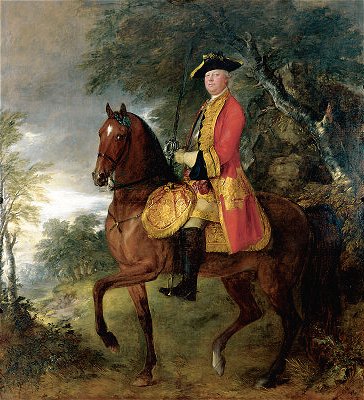 |
|
Portrait of Lieutenant General Philip
Honeywood
by Thomas Gainsborough, British 1727-1788
SN 390, Oil on Canvas 1765
by Robert Anderson.
Artist:
Thomas Gainsborough was one of the most individual geniuses in British art and one of the
most significant painters of his generation. Portraiture was his profession and landscape
painting was his pleasure. He set up as a portrait painter in 1752 doing heads and half
lengths as well as some small portraits. By 1759 he had moved to Bath and had sitters who
were members of Society. During this period he evolved a free and elegant mode of painting
which is seen in his full length portraits ( Mary, Countess Howe).
Gainsborough became a founding member of the Royal Academy and moved to
London in 1774, where he became a favorite painter of the Royal Family. it was at this
time that he developed a personal style, evolved at Bath, in which he worked with light
rapid brush strokes and evanescent colors. |
His early works show an influence of French engraving and Dutch landscape
painting. At Bath his portrait style was influenced by his admiration of Van Dyke. While
his later landscape style was often influenced by the lighting effects of Rubens, he
remained, however, an independent and original genius. His landscapes show a beautiful and
often poignant imagery of the British countryside.
Gainsborough was a contemporary rival of Sir Joshua Reynolds for whom he
had great respect and admiration. He grounded his imagery, however, on contemporary life
as opposed to the Reynolds Grand Manner.
In his personal life he was an extremely witty and cultured man with music
being his main interest outside of painting. Unlike Reynolds, Gainsborough had no interest
in literary or historical themes and detested reading.
Subject:
General Philip Honywood was a regimental colonel in the War of the Austrian Succession
(1740-1748). He was promoted to general, as was the Marquis of Granby, in the concurrant
war against Edward, the Scottish Pretender to the British throne. Honywood retired in 1746
to his estate, Marks Hall, where he enjoyed the life of a country gentleman. The general
had quite a career in which he suffered twenty-eight wounds. He was a giant of a man for
his time, measuring six feet three inches in height.
Painting:
This is by far Gainsborough's largest painting and is also his first equestrian portrait
and the only one in which the rider is actually mounted. The portrait is modeled on a
painting by Van Dyck (Charles I on Horseback) who was so greatly admired by Gainsborough.
The mature style so richly in evidence in this canvas was the result of
Gainsborough's exposure to major collections in Bath and its environs, which transformed
his art. An accomplished landscape painter, Gainsborough replicated the wooded setting of
the General's estate, Marks Hall, which evokes a tranquil mood thru the play of light.
Honywood has a glint in his eye as if he is still ready to lead the
charge. Were it not for his military garb and sword, however, he would appear more like a
country gentleman enjoying a ride on his estate, as he no doubt often did.
In this work Gainsborough sought to emulate the pictorial formulas
successfully employed by Titian and Anthony Van Dyck which combined grandeur of scale with
fluid brushwork.
Historical Context:
Prince Charles Edward Stuart, called the Young Pretender, was the son of James III (the
Old Pretender). Pretender meant claimant to the British throne. Prince Charles was also
called Bonnie Prince Charlie by his Scottish adherents. The Scottish and English
Jacobites, supported by France fomented a rebellion and invaded Scotland behind the
leadership of Charles. Some battles were won and then an invasion of England was
attempted. The English did not rally to his support as he had hoped and his army was
finally defeated by the Duke of Cumberland. It was against these Scots that both the
Marquis of Granby and General Honywood had led regiments as colonels.
|
